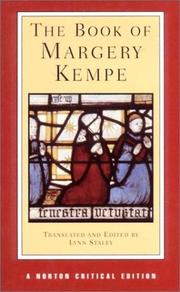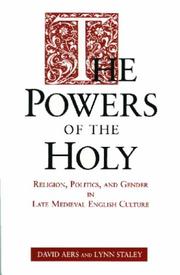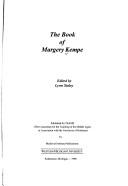| Listing 1 - 8 of 8 |
Sort by
|

ISBN: 0393976394 Year: 2001 Publisher: London ; New York, NY : W. W. Norton,
Abstract | Keywords | Export | Availability | Bookmark
 Loading...
Loading...Choose an application
- Reference Manager
- EndNote
- RefWorks (Direct export to RefWorks)
Authors, English --- Christian pilgrims and pilgrimages --- Christian women --- Mysticism --- Women and literature --- Religious life --- History --- Kempe, Margery, --- Kempe, Margery --- Authors [English ] --- Middle English, 1100-1500 --- Biography --- Early works to 1800 --- England

ISBN: 0271015411 027101542X Year: 1996 Publisher: University Park Pennsylvania State university press
Abstract | Keywords | Export | Availability | Bookmark
 Loading...
Loading...Choose an application
- Reference Manager
- EndNote
- RefWorks (Direct export to RefWorks)
English literature --- Church history --- Littérature anglaise --- Eglise --- History and criticism. --- Histoire et critique --- Histoire --- England --- Angleterre --- Religious life and customs. --- Intellectual life --- Vie religieuse --- Vie intellectuelle --- Histoire religieuse --- -British literature --- Inklings (Group of writers) --- Nonsense Club (Group of writers) --- Order of the Fancy (Group of writers) --- History and criticism --- -History and criticism --- Littérature anglaise --- Christianity --- Middle Ages, 600-1500 --- Anglii︠a︡ --- Inghilterra --- Engeland --- Inglaterra --- Anglija --- England and Wales --- ENGLISH LITERATURE --- RELIGIOUS LIFE AND CUSTOMS --- ENGLAND --- MIDDLE ENGLISH, 1100-1500 --- CHURCH HISTORY --- 1066-1485

ISBN: 1879288729 Year: 1996 Publisher: New York, NY : Western Michigan university,
Abstract | Keywords | Export | Availability | Bookmark
 Loading...
Loading...Choose an application
- Reference Manager
- EndNote
- RefWorks (Direct export to RefWorks)
Book
ISBN: 0268017824 026809280X 0268158436 Year: 2012 Publisher: University of Notre Dame Press
Abstract | Keywords | Export | Availability | Bookmark
 Loading...
Loading...Choose an application
- Reference Manager
- EndNote
- RefWorks (Direct export to RefWorks)
Book
ISBN: 0472126628 Year: 2020 Publisher: Ann Arbor, Michigan : University of Michigan Press,
Abstract | Keywords | Export | Availability | Bookmark
 Loading...
Loading...Choose an application
- Reference Manager
- EndNote
- RefWorks (Direct export to RefWorks)
Following Chaucer: Offices of the Active Life explores three representative figures--the royal woman, the poet, and the merchant--in relation to the concept of "office," which Cicero linked to the health of the republic, but Chaucer to that of the common good. Not usually conjoined to the term "office," these three figures, situated in the active life, were not firmly mapped onto the body politic, which was used to figure a relational and ordered social body ruled by the king, the head. These figures are points of entry into a set of questions rooted in Chaucer's understanding of his cultural and historical past and in his keen appraisal of the social dynamics of his own time that also reverberate in the centuries after Chaucer's death.Following Chaucer does not trace influence but uses Chaucer's likely reading, circumstances, and literary and social affiliations as guides to understanding his poetry, within the context of late medieval English culture and the reshaping of the concept of these particular offices that suited the needs of a future whose dynamics he anticipated. His understanding of the importance of the Ciceronian concept of office within the active life, his profound cultural awareness, and his probing of the foundations of social change provide him with a keen sense of the persistent tensions and inconsistencies that are fundamental to his poetry.
Book

ISBN: 9781501514210 Year: 2022 Publisher: Kalamazoo, MI
Abstract | Keywords | Export | Availability | Bookmark
 Loading...
Loading...Choose an application
- Reference Manager
- EndNote
- RefWorks (Direct export to RefWorks)
Book

ISBN: 9781526142153 Year: 2024 Publisher: Manchester : Manchester University Press,
Abstract | Keywords | Export | Availability | Bookmark
 Loading...
Loading...Choose an application
- Reference Manager
- EndNote
- RefWorks (Direct export to RefWorks)
From England and France to the Low Countries, Wales, Scotland, and Italy, the Hundred Years War (1337-1453) fundamentally shaped late-medieval literature. This volume adopts an expansive focus to reveal the transnational literary consequences of over a century of international conflict. While traditionally seen as an Anglo-French conflict, the Hundred Years War was a multilateral conflict with connections across the continent through alliances and proxy battles. Writers, whether as witnesses, diplomats, or provocateurs, played key roles in shaping the conflict, and the conflict equally impacted the course of literary history. The volume shows how a wide variety of genres and works are deeply engaged with responses to the war, from women’s visionary writing by figures like Catherine of Siena to anonymous lyric poetry, from Christine de Pizan’s Book of the City of Ladies to Geoffrey Chaucer’s Canterbury Tales.
Book

ISBN: 9781400864393 Year: 2014 Publisher: Princeton, NJ
Abstract | Keywords | Export | Availability | Bookmark
 Loading...
Loading...Choose an application
- Reference Manager
- EndNote
- RefWorks (Direct export to RefWorks)
| Listing 1 - 8 of 8 |
Sort by
|

 Search
Search Feedback
Feedback About UniCat
About UniCat  Help
Help News
News